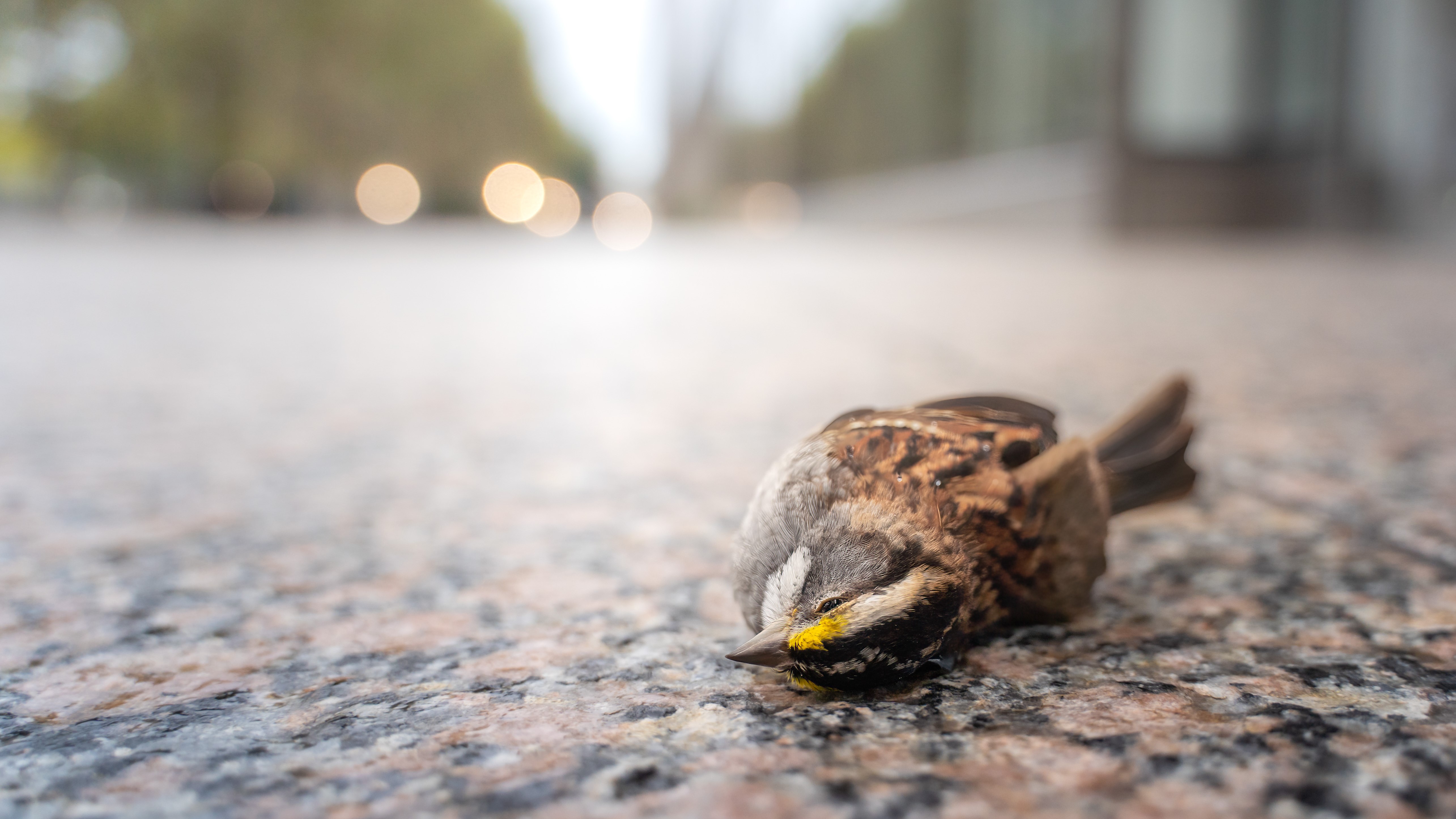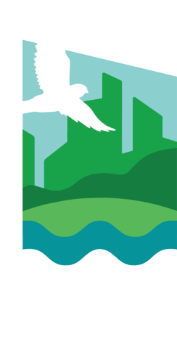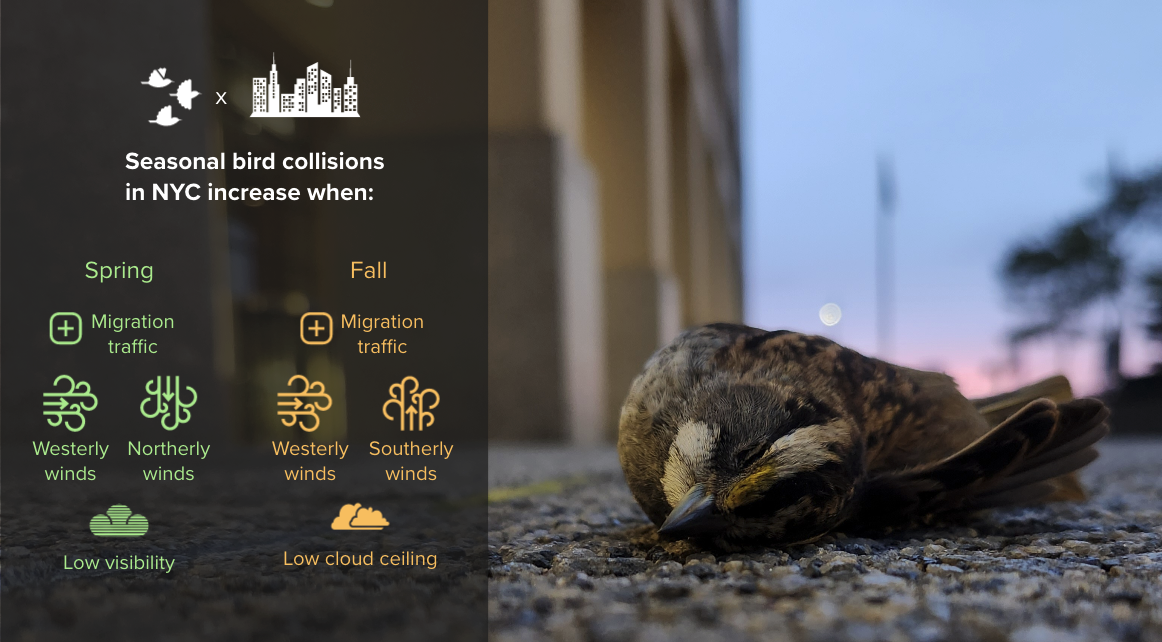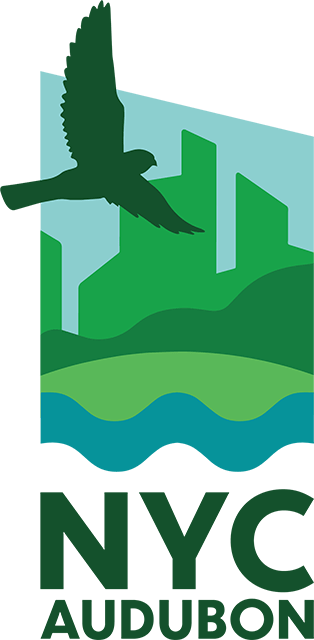Study Shows How Weather, Migration Intensity Affect Bird Collisions in New York City
category: CONSERVATIONENGAGEMENTADVOCACY

A New York City Audubon volunteer finds a White-throated Sparrow dead on the sidewalk, a victim of a collision with reflective glass. Photo: Winston Qin
Andrew Maas | February 21, 2024
Study Reveals How Weather, Migration Intensity Affect Bird Collisions in New York City
Andrew Maas | February 21, 2024
Study Reveals How Weather, Migration Intensity Affect Bird Collisions in New York City
Predicting the number of collisions during a given period will improve conservation efforts in the City and other urban areas
Up to a quarter million birds die annually from crashing into New York City’s buildings due to light pollution and reflective or clear glass. A new study in the Journal of Applied Ecology found that weather forecasts and bird migration intensity data can be used together to predict the days of greatest bird collision risk in New York City. This information can then be used to target particularly high-risk nights in New York City—and potentially, metropolises similar to New York City—for “Lights Out” initiatives that would reduce collisions more effectively.
Up to a quarter million birds die annually from crashing into New York City’s buildings due to light pollution and reflective or clear glass. A new study in the Journal of Applied Ecology found that weather forecasts and bird migration intensity data can be used together to predict the days of greatest bird collision risk in New York City. This information can then be used to target particularly high-risk nights in New York City—and potentially, metropolises similar to New York City—for “Lights Out” initiatives that would reduce collisions more effectively.
“We found that seasonally unfavorable wind directions, low visibility, and low cloud ceilings increase collision risk during both spring and fall migration, especially on nights when large numbers of birds are migrating overhead,” says Katherine Chen of Columbia University and NYC Audubon, and the lead author of the study. “Specifically, northerly and westerly winds and low visibility in the spring, as well as southerly and westerly winds and low cloud ceiling height in the fall, lead to the greatest collision risk in New York City.”
Scientists from NYC Audubon, Columbia University, the University of Canterbury, American Bird Conservancy, Great Hollow Nature Preserve & Ecological Research Center, the Cornell Lab of Ornithology, and the University of Illinois at Urbana-Champaign combined five years of bird collision data from 27 buildings in New York City with concurrent historical weather and migration data. Using this dataset, they then generated predictions of the likelihood of collisions under varying weather and migration conditions for spring and fall.
“We’d seen that during periods of high bird migration ‘traffic,’ there were mornings where volunteer collision monitors found hundreds of dead or injured birds, and mornings that were much quieter,” says study co-author Dr. Sara Kross of Columbia University and the University of Canterbury. "We suspected weather was playing a role in that variation, so we combined the two to see if we could provide more refined predictions of bird collision risk. We were lucky to have such a large dataset collected by NYC Audubon to work with, allowing us to conduct the first study that has considered the effects of weather and bird migration intensity on bird collision rates at a city-wide scale.”
“Most birds migrate at night, flying hundreds to thousands of miles in several days,” says study co-author Kaitlyn Parkins, formerly at NYC Audubon and now glass collisions program coordinator at American Bird Conservancy. “Those that land in the City to rest and refuel find themselves in an unfamiliar maze of intense lights and deadly glass. Our study shows that unfavorable weather conditions including fog, low clouds, and strong winds may amplify the effects of light pollution and cause even larger numbers of birds to land in dangerous built environments, leading to deadly window collisions."
The study used collision data from NYC Audubon’s Project Safe Flight collision monitoring program, which for over 25 years has engaged volunteers to patrol the City’s streets to look for bird strike victims during migration seasons. Using these community science data, as well as collisions reported by the public to its crowd-sourced dBird.org database, NYC Audubon partners with managers of collision-prone buildings–most recently and notably Circa Central Park–to implement bird-safe glass retrofits.
“While urban green spaces can provide quality stopover habitat for birds to rest and refuel, cities also present hazards and so research like this is important for understanding how to better mitigate those risks,” said study co-author Dr. Chad Seewagen of Great Hollow Nature Preserve & Ecological Research Center and Columbia University.
The ability to forecast both weather patterns and bird migration intensity and timing has opened new doors for conservationists to analyze and act on hazards for migratory birds. The BirdCast program, a consortium of several universities’ aeroecologists and data scientists run by the Cornell Lab of Ornithology, employs weather surveillance radar technology and machine learning algorithms to provide predictions about and near real-time insights into bird migrations. As bird migration forecasting tools continue to improve with the advances made by programs like BirdCast, conservation groups are developing customized migration alerts for cities and regions.
“Bird migration is complex and dynamic, but the fact is that we can model it, and predict it with high confidence, which affords us some exciting opportunities,” says study co-author Dr. Andrew Farnsworth, a visiting scientist at the Cornell Lab of Ornithology. “Additionally, enabling communities, in this case municipal and conservation, to understand bird movements as they happen, and with sufficient historical background to then predict what will happen with precision and accuracy, well that’s decision support to take more effective actions at its best–be it for eliminating non-essential light, treating glass, or expanding collision monitoring efforts.”
NYC Audubon helped pass Lights Out legislation in the New York City Council in 2022, requiring all City-owned and managed buildings to significantly reduce night-time lighting to weaken the lure of migrating birds into the City. But, for effective action to reduce collisions, a much larger percentage of the City’s hundreds of thousands of buildings would need to participate. A bill expanding upon this 2022 legislation requiring a significant number of commercial buildings to reduce their nighttime lighting is currently being considered for introduction in the New York City Council.
“Existing Lights Out advisories generally focus on alerting stakeholders to the times of heaviest predicted bird migration, but what we are learning in cities like New York City and Chicago is that it is also crucial to consider local weather conditions when predicting collision risk,” says study co-author Dr. Benjamin Van Doren, a BirdCast team member and Assistant Professor at the University of Illinois at Urbana-Champaign. “This study will help us better forecast bird collision risk in urban areas.”
“Temporary reductions in light pollution save migratory birds and are a great way to engage the public with the excitement and dynamism of bird migration,” Dr. Van Doren continues. “But actions that permanently reduce light pollution and encourage bird-safe building standards and window treatments are also essential steps towards reducing collisions.”
By combining both weather forecasts and bird migration forecasts, catastrophic collision events like the hundreds of birds found dead in New York City on one day in 2021 or the nearly one thousand avian fatalities found one morning at Chicago’s McCormick Place Lakeside Center last year could be avoided, as could the less visible individual collisions that make up the nearly one billion bird deaths each year in the U.S.
"This study shows the promise of using weather forecasts to determine when collision risk will be highest," says Jessica G. Wilson, executive director of New York City Audubon. "Though the study focuses on buildings in New York City, the model can be replicated in other cities to reduce the staggering number of birds that collide with buildings across the globe.”
Read the Paper in the Journal of Applied Ecology:
Katherine Chen, Sara Kross, Kaitlyn Parkins, Chad Seewagen, Andrew Farnsworth, Benjamin Van Doren. Heavy migration traffic and bad weather are a dangerous combination: bird collisions in New York City. Journal of Applied Ecology. 2024.
More Information:
- NYC Audubon’s Project Safe Flight collisions research
- American Bird Conservancy’s Glass Collision Prevention program
- Cornell Lab of Ornithology’s BirdCast migration forecasts
- NYC Audubon’s Lights Out advocacy



